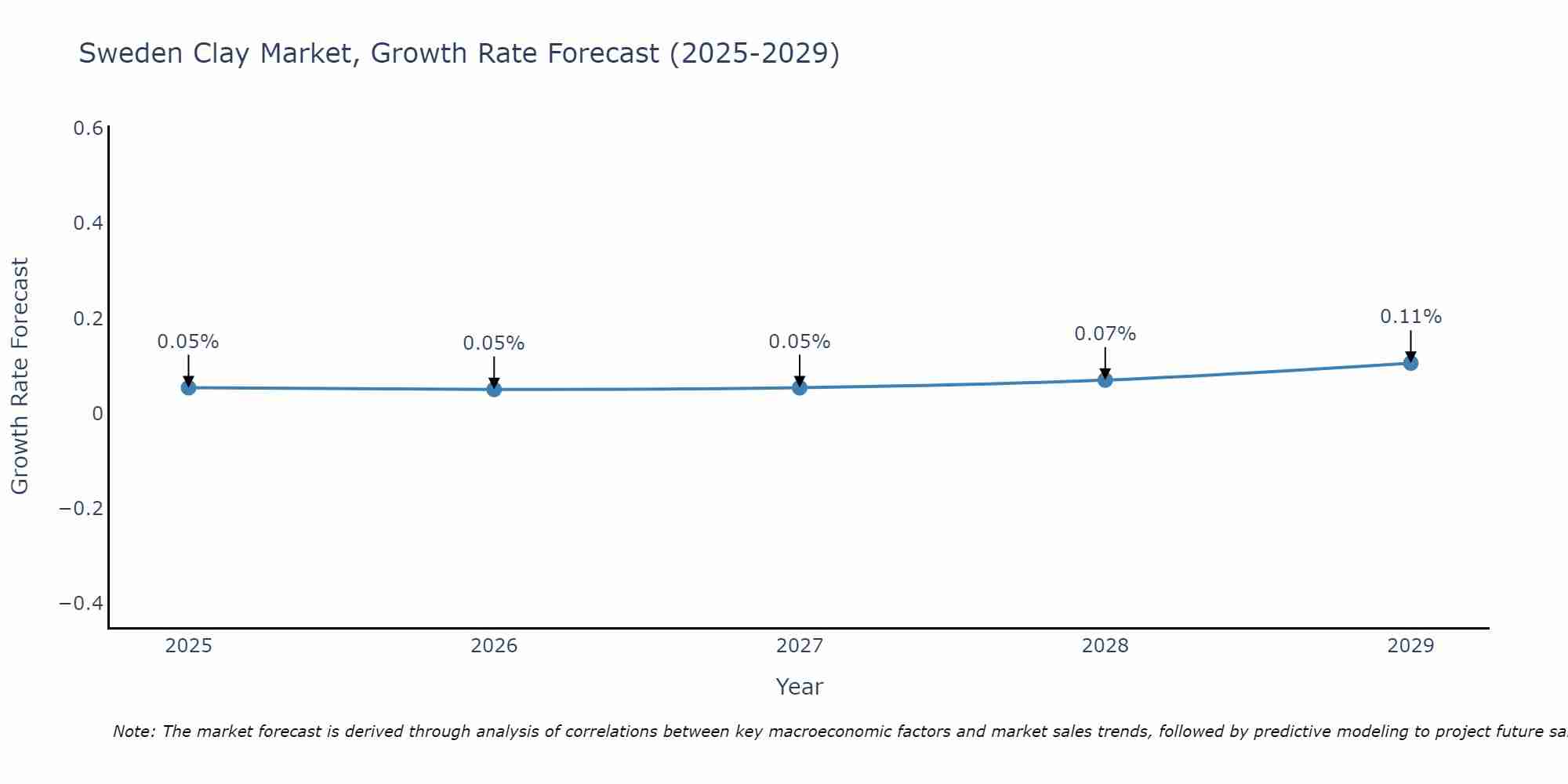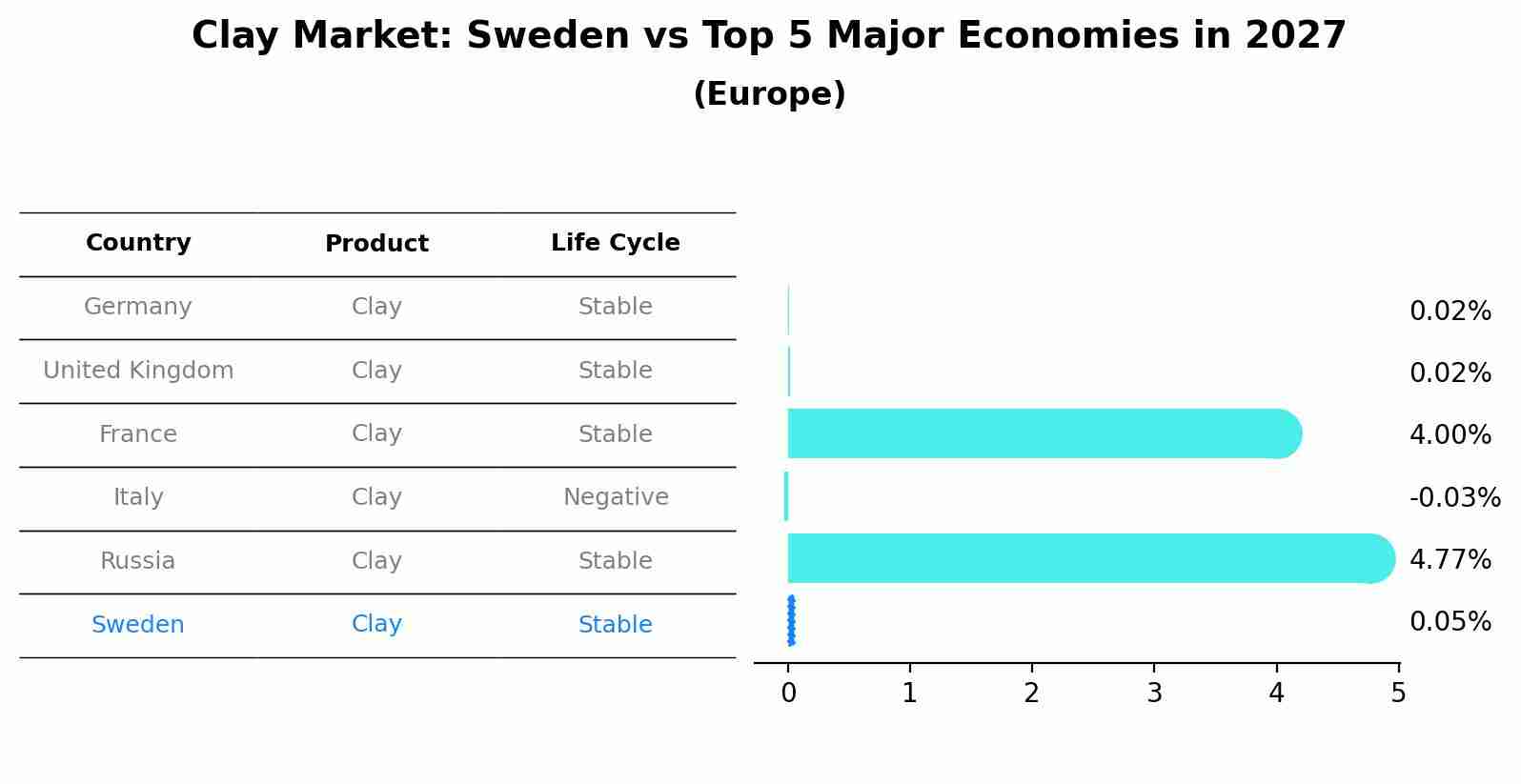Sweden Clay Market (2025-2031) | Industry, Outlook, Value, Share, Segmentation, Companies, Growth, Forecast, Revenue, Size, Analysis & Trends
| Product Code: ETC5257731 | Publication Date: Nov 2023 | Updated Date: Sep 2025 | Product Type: Market Research Report | |
| Publisher: 6Wresearch | Author: Bhawna Singh | No. of Pages: 60 | No. of Figures: 30 | No. of Tables: 5 |
Sweden Clay Market Size Growth Rate
The Sweden Clay Market is projected to witness mixed growth rate patterns during 2025 to 2029. The growth rate starts at 0.05% in 2025 and reaches 0.11% by 2029.

Clay Market: Sweden vs Top 5 Major Economies in 2027 (Europe)
Sweden's Clay market is anticipated to experience a stable growth rate of 0.05% by 2027, reflecting trends observed in the largest economy Germany, followed by United Kingdom, France, Italy and Russia.

Sweden Clay Market Overview
The clay market in Sweden is characterized by a diverse range of applications, including ceramics, construction materials, and industrial uses. With a robust manufacturing sector, Sweden is known for its production of high-quality clay products. The demand for clay is fueled by the growth in construction and ceramics industries, as well as increased interest in eco-friendly building materials. Innovations in clay processing and formulations to enhance performance properties are becoming increasingly important. Furthermore, the sustainable management of clay resources and the promotion of recycling initiatives are shaping the market dynamics in Sweden.
Drivers of the market
The clay market in Sweden is experiencing growth due to the rising demand from the construction and ceramics industries. Clay is a fundamental raw material used in various construction applications, including bricks, tiles, and pottery. The growth of the construction sector, fueled by urbanization and infrastructure development, is significantly driving this market. Moreover, the increasing interest in pottery and craft activities has led to a surge in demand for clay products among hobbyists and artists, further enhancing market potential.
Challenges of the market
The clay market in Sweden is confronted with environmental concerns, particularly related to clay mining practices, which can cause habitat destruction and environmental degradation. Additionally, stringent environmental laws in Sweden increase operational costs for clay mining companies. Another issue is the declining demand for certain types of clay products, like ceramics, due to the shift toward synthetic and alternative materials in various applications. Transportation costs for bulky clay materials can also inflate prices, making Swedish clay products less competitive on the global stage.
Government Policy of the market
The Swedish government regulates the extraction and processing of natural resources, including clay, through environmental protection laws. Policies aimed at reducing environmental impact and promoting sustainable mining practices affect the clay industry. Compliance with EU regulations related to mineral extraction and waste management is crucial for companies in the clay market, influencing operational costs and practices.
Key Highlights of the Report:
- Sweden Clay Market Outlook
- Market Size of Sweden Clay Market, 2024
- Forecast of Sweden Clay Market, 2031
- Historical Data and Forecast of Sweden Clay Revenues & Volume for the Period 2021-2031
- Sweden Clay Market Trend Evolution
- Sweden Clay Market Drivers and Challenges
- Sweden Clay Price Trends
- Sweden Clay Porter`s Five Forces
- Sweden Clay Industry Life Cycle
- Historical Data and Forecast of Sweden Clay Market Revenues & Volume By Application for the Period 2021-2031
- Historical Data and Forecast of Sweden Clay Market Revenues & Volume By Tableware for the Period 2021-2031
- Historical Data and Forecast of Sweden Clay Market Revenues & Volume By Sanitary ware for the Period 2021-2031
- Historical Data and Forecast of Sweden Clay Market Revenues & Volume By Medical applications for the Period 2021-2031
- Historical Data and Forecast of Sweden Clay Market Revenues & Volume By End Use for the Period 2021-2031
- Historical Data and Forecast of Sweden Clay Market Revenues & Volume By Ceramic and for the Period 2021-2031
- Historical Data and Forecast of Sweden Clay Market Revenues & Volume By Non-ceramic for the Period 2021-2031
- Sweden Clay Import Export Trade Statistics
- Market Opportunity Assessment By Application
- Market Opportunity Assessment By End Use
- Sweden Clay Top Companies Market Share
- Sweden Clay Competitive Benchmarking By Technical and Operational Parameters
- Sweden Clay Company Profiles
- Sweden Clay Key Strategic Recommendations
Frequently Asked Questions About the Market Study (FAQs):
1 Executive Summary |
2 Introduction |
2.1 Key Highlights of the Report |
2.2 Report Description |
2.3 Market Scope & Segmentation |
2.4 Research Methodology |
2.5 Assumptions |
3 Sweden Clay Market Overview |
3.1 Sweden Country Macro Economic Indicators |
3.2 Sweden Clay Market Revenues & Volume, 2021 & 2031F |
3.3 Sweden Clay Market - Industry Life Cycle |
3.4 Sweden Clay Market - Porter's Five Forces |
3.5 Sweden Clay Market Revenues & Volume Share, By Application, 2021 & 2031F |
3.6 Sweden Clay Market Revenues & Volume Share, By End Use, 2021 & 2031F |
4 Sweden Clay Market Dynamics |
4.1 Impact Analysis |
4.2 Market Drivers |
4.2.1 Growing construction industry in Sweden, leading to increased demand for clay for building materials. |
4.2.2 Increasing adoption of sustainable and eco-friendly construction practices, where clay is a preferred material. |
4.2.3 Government initiatives promoting the use of locally-sourced materials like clay in construction projects. |
4.3 Market Restraints |
4.3.1 Fluctuations in raw material prices impacting the overall production costs of clay products. |
4.3.2 Competition from alternative building materials like concrete and steel affecting the market share of clay products. |
4.3.3 Environmental regulations and restrictions on clay mining and processing activities impacting the supply chain. |
5 Sweden Clay Market Trends |
6 Sweden Clay Market Segmentations |
6.1 Sweden Clay Market, By Application |
6.1.1 Overview and Analysis |
6.1.2 Sweden Clay Market Revenues & Volume, By Tableware, 2021-2031F |
6.1.3 Sweden Clay Market Revenues & Volume, By Sanitary ware, 2021-2031F |
6.1.4 Sweden Clay Market Revenues & Volume, By Medical applications, 2021-2031F |
6.2 Sweden Clay Market, By End Use |
6.2.1 Overview and Analysis |
6.2.2 Sweden Clay Market Revenues & Volume, By Ceramic and, 2021-2031F |
6.2.3 Sweden Clay Market Revenues & Volume, By Non-ceramic, 2021-2031F |
7 Sweden Clay Market Import-Export Trade Statistics |
7.1 Sweden Clay Market Export to Major Countries |
7.2 Sweden Clay Market Imports from Major Countries |
8 Sweden Clay Market Key Performance Indicators |
8.1 Percentage increase in the number of construction projects using clay as a primary building material. |
8.2 Average lead time for clay product manufacturing and delivery to construction sites. |
8.3 Number of partnerships or collaborations between clay suppliers and construction companies for innovative product development using clay. |
8.4 Carbon footprint reduction achieved by using clay-based construction materials. |
8.5 Percentage increase in the adoption of clay products in non-residential construction projects. |
9 Sweden Clay Market - Opportunity Assessment |
9.1 Sweden Clay Market Opportunity Assessment, By Application, 2021 & 2031F |
9.2 Sweden Clay Market Opportunity Assessment, By End Use, 2021 & 2031F |
10 Sweden Clay Market - Competitive Landscape |
10.1 Sweden Clay Market Revenue Share, By Companies, 2024 |
10.2 Sweden Clay Market Competitive Benchmarking, By Operating and Technical Parameters |
11 Company Profiles |
12 Recommendations | 13 Disclaimer |
- Single User License$ 1,995
- Department License$ 2,400
- Site License$ 3,120
- Global License$ 3,795
Search
Related Reports
- ASEAN and Thailand Brain Health Supplements Market (2025-2031) | Strategy, Consumer Insights, Analysis, Investment Trends, Opportunities, Growth, Size, Share, Industry, Revenue, Segments, Value, Segmentation, Supply, Forecast, Restraints, Outlook, Competition, Drivers, Trends, Demand, Pricing Analysis, Competitive, Strategic Insights, Companies, Challenges
- ASEAN Bearings Market (2025-2031) | Strategy, Consumer Insights, Analysis, Investment Trends, Opportunities, Growth, Size, Share, Industry, Revenue, Segments, Value, Segmentation, Supply, Forecast, Restraints, Outlook, Competition, Drivers, Trends, Demand, Pricing Analysis, Competitive, Strategic Insights, Companies, Challenges
- Europe Flooring Market (2025-2031) | Outlook, Share, Industry, Trends, Forecast, Companies, Revenue, Size, Analysis, Growth & Value
- Saudi Arabia Manlift Market (2025-2031) | Outlook, Size, Growth, Trends, Companies, Industry, Revenue, Value, Share, Forecast & Analysis
- Uganda Excavator, Crane, and Wheel Loaders Market (2025-2031) | Strategy, Consumer Insights, Analysis, Investment Trends, Opportunities, Growth, Size, Share, Industry, Revenue, Segments, Value, Segmentation, Supply, Forecast, Restraints, Outlook, Competition, Drivers, Trends, Demand, Pricing Analysis, Competitive, Strategic Insights, Companies, Challenges
- Rwanda Excavator, Crane, and Wheel Loaders Market (2025-2031) | Strategy, Consumer Insights, Analysis, Investment Trends, Opportunities, Growth, Size, Share, Industry, Revenue, Segments, Value, Segmentation, Supply, Forecast, Restraints, Outlook, Competition, Drivers, Trends, Demand, Pricing Analysis, Competitive, Strategic Insights, Companies, Challenges
- Kenya Excavator, Crane, and Wheel Loaders Market (2025-2031) | Strategy, Consumer Insights, Analysis, Investment Trends, Opportunities, Growth, Size, Share, Industry, Revenue, Segments, Value, Segmentation, Supply, Forecast, Restraints, Outlook, Competition, Drivers, Trends, Demand, Pricing Analysis, Competitive, Strategic Insights, Companies, Challenges
- Angola Excavator, Crane, and Wheel Loaders Market (2025-2031) | Strategy, Consumer Insights, Analysis, Investment Trends, Opportunities, Growth, Size, Share, Industry, Revenue, Segments, Value, Segmentation, Supply, Forecast, Restraints, Outlook, Competition, Drivers, Trends, Demand, Pricing Analysis, Competitive, Strategic Insights, Companies, Challenges
- Israel Intelligent Transport System Market (2025-2031) | Strategy, Consumer Insights, Analysis, Investment Trends, Opportunities, Growth, Size, Share, Industry, Revenue, Segments, Value, Segmentation, Supply, Forecast, Restraints, Outlook, Competition, Drivers, Trends, Demand, Pricing Analysis, Competitive, Strategic Insights, Companies, Challenges
- Uganda Precast and Aggregate Market (2025-2031) | Strategy, Consumer Insights, Analysis, Investment Trends, Opportunities, Growth, Size, Share, Industry, Revenue, Segments, Value, Segmentation, Supply, Forecast, Restraints, Outlook, Competition, Drivers, Trends, Demand, Pricing Analysis, Competitive, Strategic Insights, Companies, Challenges
Industry Events and Analyst Meet
Our Clients
Whitepaper
- Middle East & Africa Commercial Security Market Click here to view more.
- Middle East & Africa Fire Safety Systems & Equipment Market Click here to view more.
- GCC Drone Market Click here to view more.
- Middle East Lighting Fixture Market Click here to view more.
- GCC Physical & Perimeter Security Market Click here to view more.
6WResearch In News
- Doha a strategic location for EV manufacturing hub: IPA Qatar
- Demand for luxury TVs surging in the GCC, says Samsung
- Empowering Growth: The Thriving Journey of Bangladesh’s Cable Industry
- Demand for luxury TVs surging in the GCC, says Samsung
- Video call with a traditional healer? Once unthinkable, it’s now common in South Africa
- Intelligent Buildings To Smooth GCC’s Path To Net Zero













